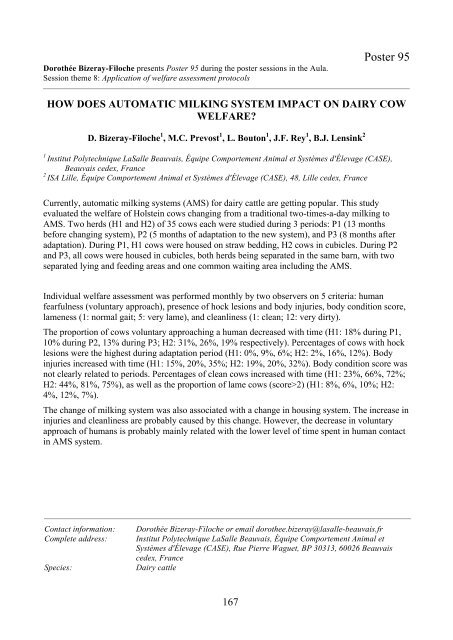Acknowledgements Book of abstracts - Publicaties - Vlaanderen.be
Acknowledgements Book of abstracts - Publicaties - Vlaanderen.be
Acknowledgements Book of abstracts - Publicaties - Vlaanderen.be
You also want an ePaper? Increase the reach of your titles
YUMPU automatically turns print PDFs into web optimized ePapers that Google loves.
Dorothée Bizeray-Filoche presents Poster 95 during the poster sessions in the Aula.<br />
Session theme 8: Application <strong>of</strong> welfare assessment protocols<br />
167<br />
Poster 95<br />
HOW DOES AUTOMATIC MILKING SYSTEM IMPACT ON DAIRY COW<br />
WELFARE?<br />
D. Bizeray-Filoche 1 , M.C. Prevost 1 , L. Bouton 1 , J.F. Rey 1 , B.J. Lensink 2<br />
1<br />
Institut Polytechnique LaSalle Beauvais, Équipe Comportement Animal et Systèmes d'Élevage (CASE),<br />
Beauvais cedex, France<br />
2<br />
ISA Lille, Équipe Comportement Animal et Systèmes d'Élevage (CASE), 48, Lille cedex, France<br />
Currently, automatic milking systems (AMS) for dairy cattle are getting popular. This study<br />
evaluated the welfare <strong>of</strong> Holstein cows changing from a traditional two-times-a-day milking to<br />
AMS. Two herds (H1 and H2) <strong>of</strong> 35 cows each were studied during 3 periods: P1 (13 months<br />
<strong>be</strong>fore changing system), P2 (5 months <strong>of</strong> adaptation to the new system), and P3 (8 months after<br />
adaptation). During P1, H1 cows were housed on straw <strong>be</strong>dding, H2 cows in cubicles. During P2<br />
and P3, all cows were housed in cubicles, both herds <strong>be</strong>ing separated in the same barn, with two<br />
separated lying and feeding areas and one common waiting area including the AMS.<br />
Individual welfare assessment was performed monthly by two observers on 5 criteria: human<br />
fearfulness (voluntary approach), presence <strong>of</strong> hock lesions and body injuries, body condition score,<br />
lameness (1: normal gait; 5: very lame), and cleanliness (1: clean; 12: very dirty).<br />
The proportion <strong>of</strong> cows voluntary approaching a human decreased with time (H1: 18% during P1,<br />
10% during P2, 13% during P3; H2: 31%, 26%, 19% respectively). Percentages <strong>of</strong> cows with hock<br />
lesions were the highest during adaptation period (H1: 0%, 9%, 6%; H2: 2%, 16%, 12%). Body<br />
injuries increased with time (H1: 15%, 20%, 35%; H2: 19%, 20%, 32%). Body condition score was<br />
not clearly related to periods. Percentages <strong>of</strong> clean cows increased with time (H1: 23%, 66%, 72%;<br />
H2: 44%, 81%, 75%), as well as the proportion <strong>of</strong> lame cows (score>2) (H1: 8%, 6%, 10%; H2:<br />
4%, 12%, 7%).<br />
The change <strong>of</strong> milking system was also associated with a change in housing system. The increase in<br />
injuries and cleanliness are probably caused by this change. However, the decrease in voluntary<br />
approach <strong>of</strong> humans is probably mainly related with the lower level <strong>of</strong> time spent in human contact<br />
in AMS system.<br />
Contact information: Dorothée Bizeray-Filoche or email dorothee.bizeray@lasalle-<strong>be</strong>auvais.fr<br />
Complete address: Institut Polytechnique LaSalle Beauvais, Équipe Comportement Animal et<br />
Systèmes d'Élevage (CASE), Rue Pierre Waguet, BP 30313, 60026 Beauvais<br />
cedex, France<br />
Species: Dairy cattle
















